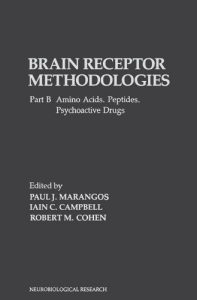Brain Receptor Methodologies: Part B Amino Acids. Peptides. Psychoactive Drugs is the second of the two-part first volume of the Neurobiological Research series, which provides a comprehensive view of various subdisciplines within neurobiology. The first volume (Parts A and B) deals with the area of neurotransmitter and neuromodulator receptors in brain; future volumes will cover the subdisciplines of neuroanatomy, neurophysiology, brain-specific macromolecules, neurochemistry, and behavioral neurobiology. It is hoped that the series will be of equal value for both basic as well as clinical scientists
Part B continues from Part A with the remainder of Section II, specific receptor binding methodologies. Subsection II,B deals with receptors for amino acids and neuropeptides and covers areas including GABA, glycine, carnosine, opiates, bombesin, CCK, TRH, and substance P. Amino acids probably represent the majority of brain neurotransmitter substances, at least relative to the amines and acetylcholine, although with the exception of GABA, the amino acids remain relatively uncharacterized in brain. Their further study should receive high priority.
Part B continues from Part A with the remainder of Section II, specific receptor binding methodologies. Subsection II,B deals with receptors for amino acids and neuropeptides and covers areas including GABA, glycine, carnosine, opiates, bombesin, CCK, TRH, and substance P. Amino acids probably represent the majority of brain neurotransmitter substances, at least relative to the amines and acetylcholine, although with the exception of GABA, the amino acids remain relatively uncharacterized in brain. Their further study should receive high priority.






